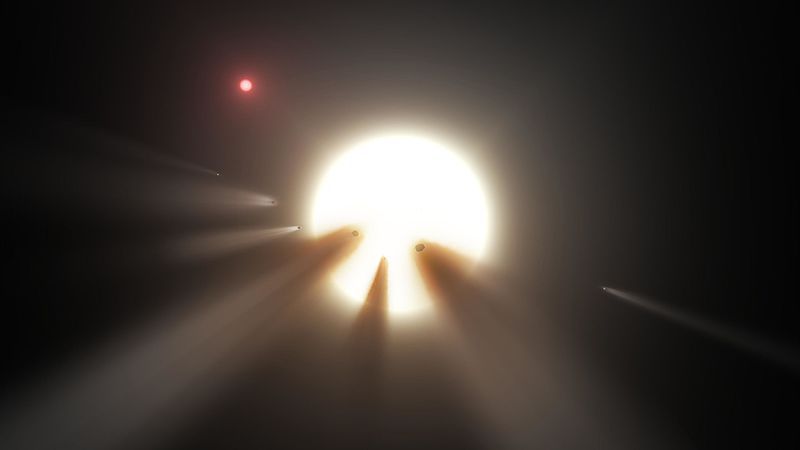
The bizarre behaviour of a star 1,300 light years from Earth may have finally been explained. NASA says the big dips in brightness of the star—KIC 8462852—could be down to a massive, uneven cloud of dust moving around it.
This is far less of an exotic explanation than other theories proposed over the last few years, which include an "alien megastructure" built by some advanced extraterrestrial civilization to harness power from the star.
Scientists first announced that they had observed weird dips in the brightness of KIC 8462852 in 2015. Normally, when you observe a star and an object—a planet, for example—passes in front of it, there is a small dip in the amount of light coming from that star. Because the size of the planet is fixed, the dip would happen at regular intervals and would block the same amount of light each time. But this is not what happened with KIC 8462852.
What the astronomers saw were huge fluctuations in the star's brightness, ranging from two percent up to 20 percent, at irregular intervals. To block this much of the star's light, the object must be extraordinarily large—a Jupiter-sized planet would block about two percent of the light from our sun.
Many hypotheses have been put forward over the last few years, including a massive swarm of comets and a giant ringed planet orbiting very close to KIC 8462852. None of these explanations quite explain what was being offered, however.
In an interview with Newsweek earlier this year, Louisiana State University's Tabetha Boyajian, who first discovered the dimming, said: "Every theory that's been proposed is [far more extreme] than what we know to exist now. So we're looking for a solution that works with a reasonable physical mechanism we can postulate."
However, the mystery may now have been solved. In a study published in The Astrophysical Journal, researchers used NASA's Spitzer and Swift missions to examine the dimming in different wavelengths. What they found was there was less dimming when looking at the star in infrared light than when they observed it in ultraviolet.
If the cause of the dimming was anything bigger than dust particles, then the dimming in different wavelengths would be the same. "This pretty much rules out the alien megastructure theory, as that could not explain the wavelength-dependent dimming," lead author Huan Meng, at the University of Arizona, Tucson, said in a statement from NASA. "We suspect, instead, there is a cloud of dust orbiting the star with a roughly 700-day orbital period."

The team observed KIC 8462852 between January and December last year. Findings showed the dimming was more pronounced in the infrared wavelength, suggesting the particles are bigger than interstellar dust—tiny particles that cannot remain in orbit around a star because pressure would drive it away.
This meant there was only one plausible explanation—circumstellar dust. This is bigger than interstellar dust, but no so big that the dimming would become uniform across the various wavelengths. Concluding, the authors say a huge, uneven cloud of circumstellar dust could explain the irregular dimming observed.
Their hypothesis comes with problems. It does not address short-term dimming events seen, nor does it explain the dips where 20 percent of the star's light is blocked. Potentially, the dimming could be the result of this dust cloud combined with a massive swarm of comets. However, further research will be needed to fully solve the mystery of KIC 8462852.
Uncommon Knowledge
Newsweek is committed to challenging conventional wisdom and finding connections in the search for common ground.
Newsweek is committed to challenging conventional wisdom and finding connections in the search for common ground.
About the writer
Hannah Osborne is Nesweek's Science Editor, based in London, UK. Hannah joined Newsweek in 2017 from IBTimes UK. She is ... Read more
To read how Newsweek uses AI as a newsroom tool, Click here.








